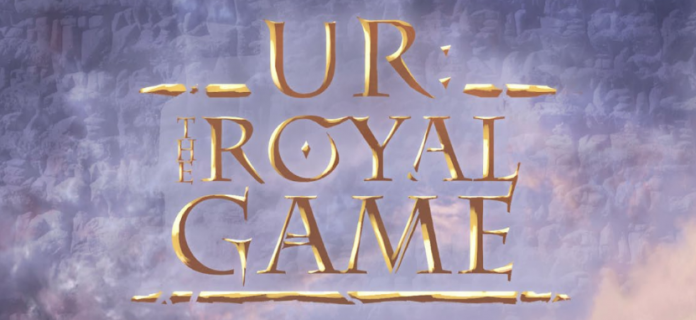We’re used to reviewing new releases here at Goonhammer. I think, with Ur: The Royal Game we might be reviewing the oldest possible version of our hobby. There’s a lot of versions of Ur out there, but few like this. Ur: The Royal Game is a new interpretation of the most ancient known board game, produced by Spartan Development. There’s a lot in this new version to like, updating the ancient rules, which you can read more about here, for the modern day.
Before we dive in here we’d like to thank Spartan Development for providing us with a preview copy of the game for review purposes.
The Game of Ur
We’ll talk more about the origins – and rules – of the Game of Ur in another article, but for now let’s take the broad strokes. The Game of Ur was a race game, where two players competed to move pieces through a track and off the board. You probably know race games – Ludo, the bane of every family board game collection, Parcheesi (or in its less-American-branded form, Pachisi), and Snakes and Ladders are all forms of race games. If you’ve spent time in an old-time drinking establishment, you’ve probably spent a couple of hundred hours getting beaten at Backgammon, a venerable old hand of the form. The Game of Ur might well be the grandad of them all, one of the very first known board games, originating at some time in the early third millennium BCE.
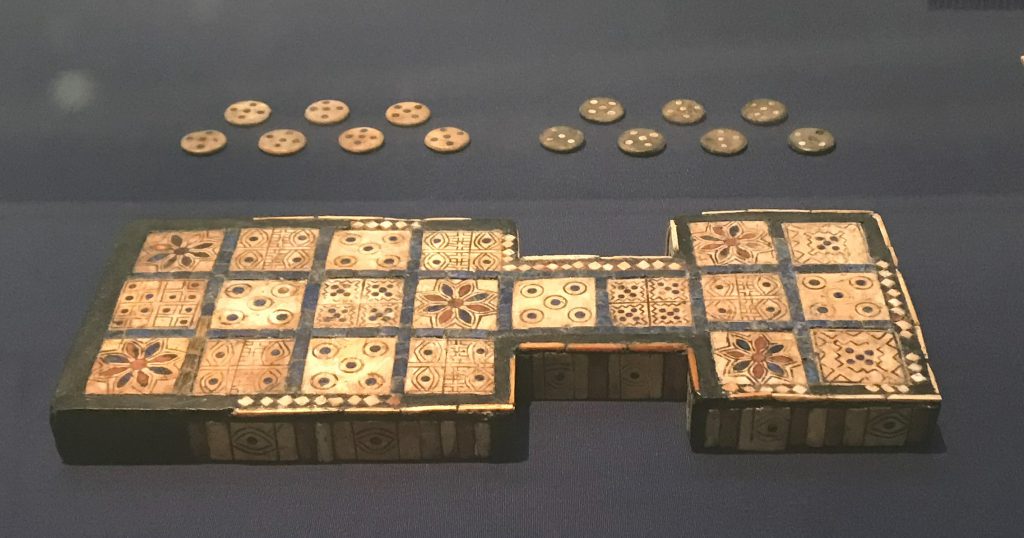
Whenever and wherever it originated, the Game of Ur seems to have been extremely popular. Versions have been found all over the middle east from Crete to the Indian Subcontinent, token and board designs varied hugely.
The game involved moving your playing pieces through a course – usually around the edges and through the centre of the board – until you can remove them, scoring a point. In the meantime, your opponent is doing the same while capturing your pieces from the board, forcing you to bring them back on. Depending on the wagers you’re placing, its a classic gambling experience – and the board presumably scratched onto the statues lining the entrance of Sargon II’s palace it by guards was probably made for a quick way to get someone else’s salary.
Since then, the ancient game has enjoyed a resurgence, usually based on what’s become known as the “Finkel Rules,” and now Spartan Development are bringing a new and modern version to the world. Let’s see how it holds up.
UR: The Royal Game
Both the rules and board for Ur have changed over the course of the centuries in which the game was played, but the core remains the same, and that’s what Spartan Games have brought to us with the new Kickstarter version. Based on the Finkel Rules and Leonard Woolley-discovered board, Spartan Games have adapted and updated the rules to turn the game of Ur from a chase game that can also divine the future into a much more modern strategy game.
What’s In the Box
Note: I reviewed a beta copy of both rules and components – final Kickstarter version may change!
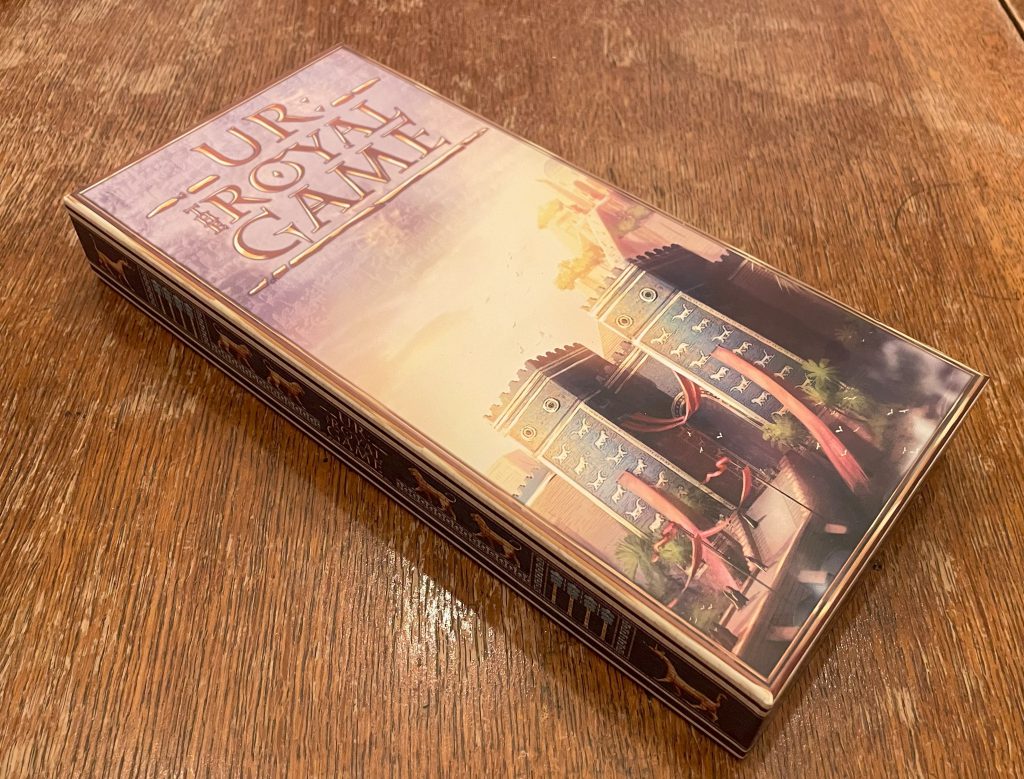
The game arrives in a nice, slim box with full-colour illustration at a size you can slide into even the most overwhelming board game collection. Taking design cues from the Woolley-discovered boards and playing pieces, Ur: The Royal Game comes with a nicely-done board, the classic tipped d4s used in the original game, and coloured playing pieces for each team. It would have been easy to do away with the original style dice, and I’m glad Spartan Games didn’t as this really adds to the experience. It’ll take a little longer to get used to deciphering what you roll, but it also adds some interesting different results, allowing you to spawn pieces on key tiles on a lucky roll. While a D4 lets you add up numbers for movement a lot quicker, it doesn’t include null or “special” rolls without forcing you back into using categories anyway, so utilising the tips-and-pips “original” dice both adds to the aesthetic experience and allows Spartan Games to push a more strategic version of play.
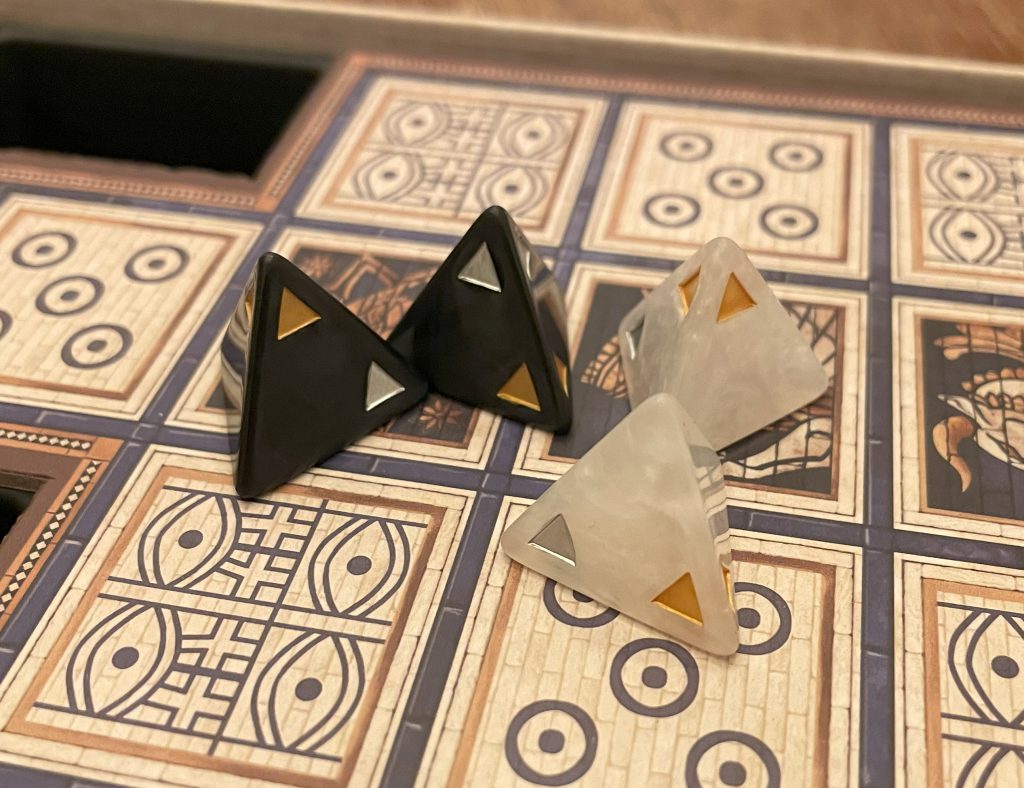
It’s a very well produced version of the game aesthetically, with cues from Babylonian and Assyrian art. If the final Kickstarter version looks like the review copy, I’d be very happy with the quality and look of the components received. There’s a really nice extra in that the board is double-sided, so you have the “classic” version right there for you too. The board fitting back into the insert is clever – making for a self-contained play area that really evokes the archaeological versions, without the need for a much more expensive wooden box.
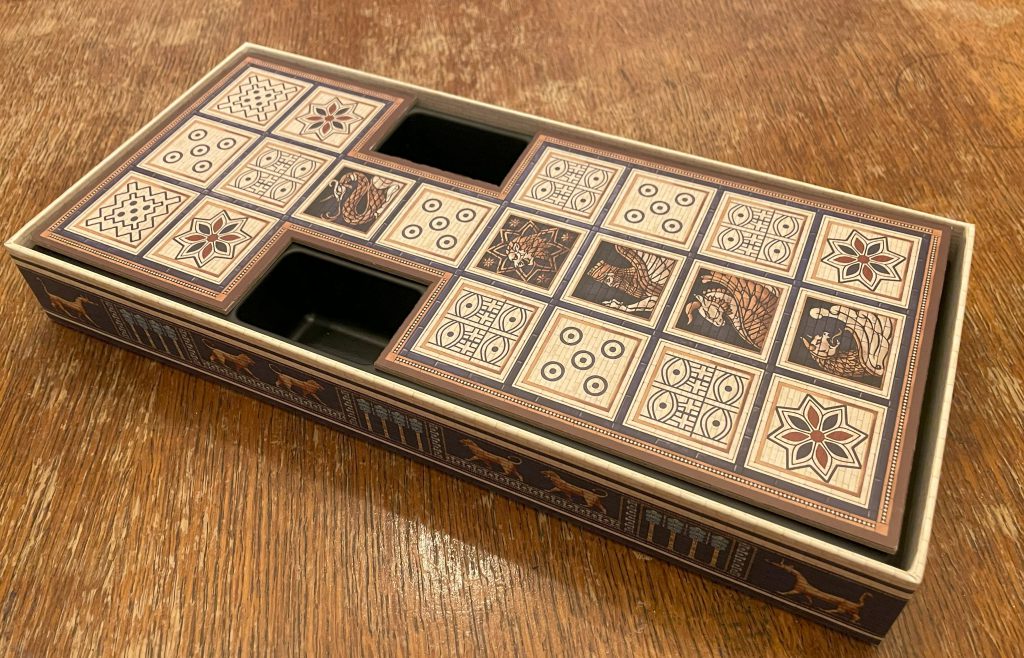
That’s definitely a draw, but I hope the Kickstarter has an option for a “premium” set, because one of the draws for me with the game of Ur is that we could recreate the finest gameboard yet found – illustrated above – with the five-pip counters and a fully wooden board.

While the bits are nice, the real draw here is the rules. The Game of Ur is fairly rules-light, which works well – particularly for gambling – or pub-style gaming where the game is an ancillary to socialising and drinking. However, the Spartan Games version goes a little further by adding an additional layer of positional strategy. The original game has a fairly simple division between types of tile – rosette and normal – and, depending on the rules, safe and combat positions. Spartan Games have added in new tile types, new places you can add a piece to the board, and, crucially, a new win mechanic.
Now, instead of running your pieces off the board to victory, and relying largely on chance to get there, the game of Ur is a strategy and position game, where occupying and holding the rosette points (forts in this version) brings victory, and you can surprise opponents with cunning token placement far up the board. Capturing tiles can lead to dominating an area (“Heaven” and “Earth”), which both grant powerful benefits, and securing both wins you the game. These rule changes still feel very much in keeping with the spirit of the game, both in a physical sense in that fit well into the board and in the metaphysical sense, making use of the divinatory and religious elements of the game to support new rules.
My Ur
I was, if I’m honest, a bit sceptical of all these changes, because I’ve got a couple of versions of Ur, one of which I’ve spent dozens if not hundreds of hours playing with over the years. Usually that’s been in a pub, though I have also played it in the British Museum and, memorably, as close to Ur as I’ve got, in Jordan. So I’m pretty familiar with the game, often playing with a handful of pennies (or promises of drinks) as an incentive. I’ve usually played it with one eye on socialising with an opponent or generally chatting about nonsense, because while there’s definitely strategy there, the Finkel rules are driven entirely by rolls. Where you are on the board matters, but (with the exception of the rosettes) only in relation to your enemy’s pieces, so while you can agonise over where and when you place pieces on the board, or if you want to load up your entrance area before sending individual pieces out, travel en masse etc, you can play it with a couple of drinks and a good chat too.
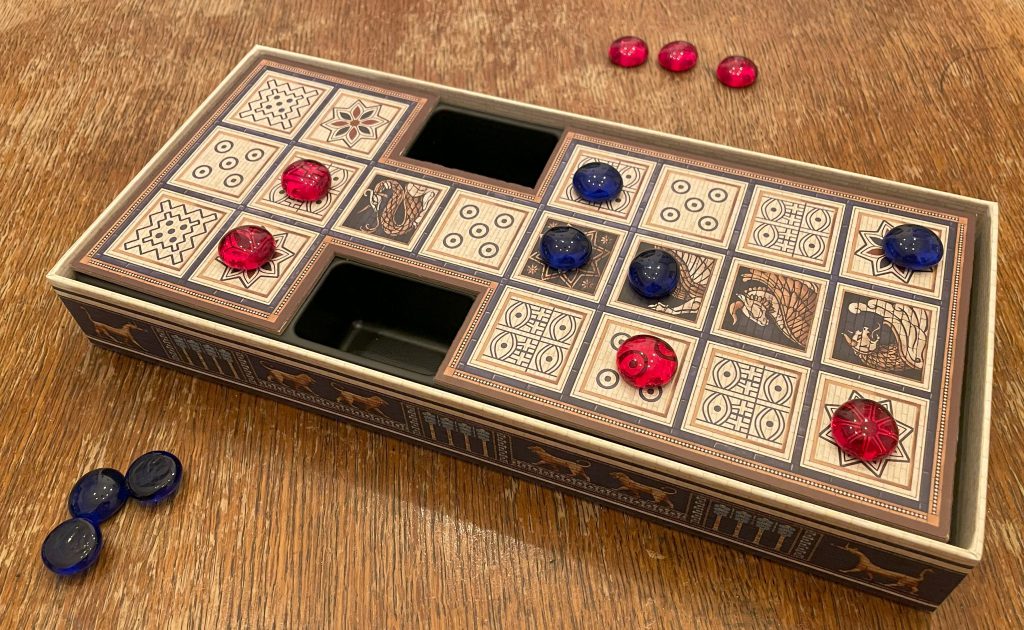
After playing a couple of games of Ur: The Royal Game, I realised this isn’t that. This is Ur as a proper, positional strategy game. There are bonuses, there are tricks that can be played, there are positions to be won, reinforced, defended and shepherded. I think, as it stands at the moment with the work in progress rules I received for review, it’s a much more modern, thoughtful, game. My games were back and forth, about positioning and trying to bait out a hasty capture, picking off pieces and trying to secure areas of the board, only to be undone by the new placement rules undermining my best laid plans. After coming in to this thinking “it’s game of Ur, I know this” I realised I didn’t – I was playing a much more intense and interesting game, one that required focus and thought and one I enjoyed playing. I think the original game of Ur is still there for those times when you’re playing a game more for a chat than anything else, but in turning a betting/telling the future experience into a strategic one, I think Spartan Developement have done a great job.
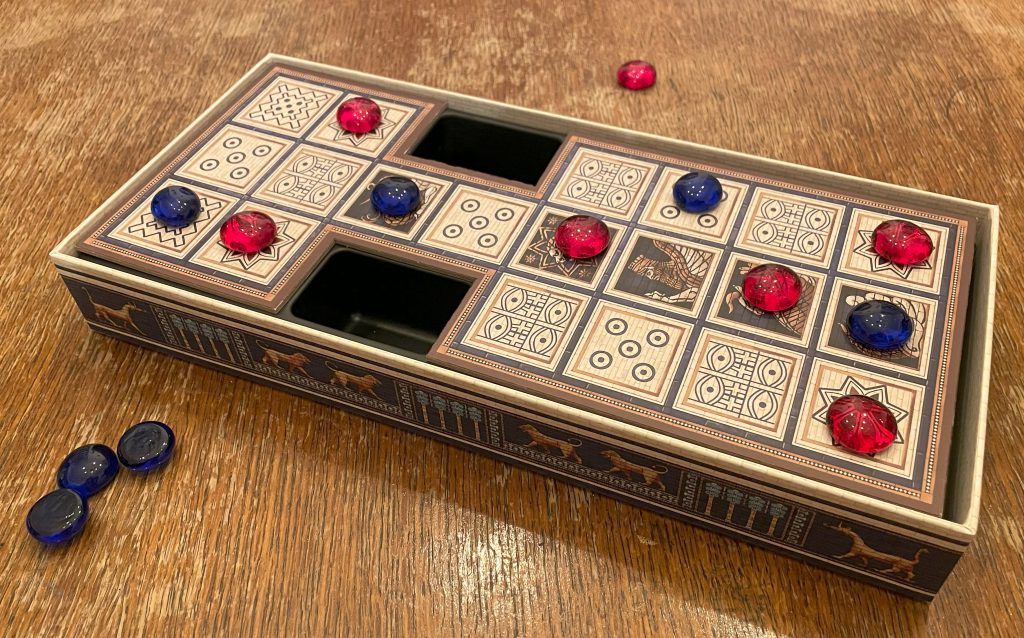
There are a few issues – I think if you’re lucky you can create a near completely unassailable position, locking your opponent in, and I’m not sure if you can spawn a piece on top of an enemy’s piece (if not, might be a good shout for the all-powerful tile of Ishtar). It might well be me not reading these correctly (it’s been known to happen), or the inertia of changing how I see the board, but these did pose a bit of a puzzle to me and I hope there’s a clarification in the offing for the final Kickstarter version.
In all, it’s a really interesting proposition – taking the mechanics and the vibe from the original game and working with those to produce a tense, back-and-forth positional experience. The new rules are an interesting twist and add layers of strategy that will bear repeated games, and, if it comes to it, you can always play the old version of the game on the board too! With highly finished board and overall high quality components, this is Ur for the modern age and the modern game collection, and I think that’s a really good thing. Ultimately, whether you know your Gilgamesh from your Ubara-Tutu and can tell the difference between the Sargons with ease, or your experience with Babylonian and Assyrian culture is that one Star Trek episode, I think this is well worth a look.
You can check out the Kickstarter for Ur: The Royal Game here. It’s coming soon but you can expect it to go live in the next month or so.
Questions, comments, suggestions? Email us at contact@goonhammer.com or leave a comment below.
